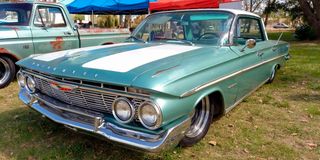Premium
A newer, smaller engine in a big antique car? Buy painkillers

Chevrolet.
I have an old Chevrolet saloon with a huge and greedy engine. Is it possible to change to a Toyota engine of a lesser capacity for economy in fuel consumption? Nicholas.
In theory, it is technically possible to fit almost any engine in almost any vehicle body, however, it is always difficult, sometimes very complex, and rarely economic, to do so.

Chevrolet Chevy Bel Air sedan four door,1961.
Apart from the overall size and shape of an engine having to fit in the available space, each engine has mountings of different designs and locations for attachment to the chassis, and the interface between the back of the engine and the clutch/transmission must also be adapted, or the gearbox must be changed, and then the final drive ratios, too.
Most or all of the engine ‘dressings’ might also not fit, and there could be issues such as the distance between the fan and the radiator and all sorts of other conundrums. An old Chev engine to a modern Toyota engine sounds like attempted self-immolation.

Chevrolet 400 Chevy II 6 four door sedan, 1960s by GM Argentina.
Further, even if you managed to fit a smaller engine, you might, (or might not) achieve the goal of lower fuel consumption, and would almost certainly experience other side effects.
The Chev probably has a very heavy body and its engine is probably high on torque, with a heavy flywheel meshed to a specific set of gearbox ratios and a final drive compatible with that power-to-weight requirement. The Toyota engine you fit might be relatively low on torque and high on horsepower with a light flywheel, and have completely wrong ratios for the job of propelling a heavy car. At best, it may be no less fuel-thirsty, and at worst, the vehicle might be almost undrivable.

1956 blue Chevrolet 4 door.
If you’re keen to keep your old Chev, and its engine is working properly, I’d advise you to keep them both together. Or buy a Toyota with an engine in it, and keep them both together. It could cost you more to change than you are likely to save in fuel. You would also incur a major expense in headache pills and sedatives.
If you want to keep the Chev but its engine is not serviceable, then look for a replacement engine with similar characteristics to the old one. The modern equivalent of an engine designed to work in an old Chev may be much more fuel efficient, even if it is not smaller.
Quality and choice almost always comes down to cost

A motor vehicle assembly plant.
Gavin,
What are the advantages of a strong metal car body over the plastics or other synthetics commonly used? Daniel
The earliest car bodies were made of wood, with iron brackets and bolts to join them together and reinforce stress points. But evolution in car design, performance and industrial manufacturing processes, especially mass production, quite quickly changed that.
For the following century, steel has been used in most cars because it is the cheapest and most readily available material for the job of making car bodies that is also suitable for the job those bodies have to do. It is also very compatible with mass production processes.

Its downsides of relatively heavy weight and tendency to rust are tolerated, with compensations like ever-better surface coatings (paints and underseals), and sometimes substituting low-stress components with (much) lighter aluminium or designs and techniques which enable the use of thinner steel plate. Fifty years ago, you could walk across the middle of the bonnet of a car with no risk of denting it. Don’t try that now. Thinner steel, “plastics” (and later fibreglass) have been increasingly used in areas where they are “strong enough”, usually the body skin and trim, not structural elements, because they are lighter.
More recently, very high-tech synthetic “aramid super-fibres” like Kevlar (invented by the late Stephanie Kwolek in 1965, by the way) and subsequent equivalents with other brand names, have been developed.
They are lighter than aluminium and stronger than steel – many, many times stronger weight-for-weight. So strong that Kevlar is used for making armour-piercing bullets! And hundreds of other things. It can also be formed into almost any shape. The main reason not to use it for all car bodies, including the highest-stress structural elements, is its very high cost.
You do know one type of car that is made this way. Formula One racing cars. As an indicator of their price, their tiny wing mirror housings cost no less than Sh100, 000. To them, the tendency for Kevlar to degrade if exposed to alkaline conditions or chlorine is irrelevant.
But wait. While Kevlar (etc) has revolutionised the design and performance of thousands of different items, it is now old-hat. There is now another material that could revolutionise the industry itself. It is called Graphene.
It is not just strong and light. It is both the strongest and the lightest material we have ever produced, and it is also flexible, transparent and thermally conductive. The only limit to its potential applications is human imagination.
Cost is almost certain to be a major inhibitor, but more than a few inventions that have been developed and tested have not been widely produced or market-released for many years (even decades) if their availability is likely to undermine existing technology that is already installed and profitable (everything from adhesives to razor blades have been in that time warp) or if the raw materials for making it are not available in sufficient quantity to meet mass market demand.
In the case of Graphene, all of these caveats might apply to an unprecedented degree. It is not unheard of for the time-lapse between discovery and distribution to be occupied by military purposes.
When buying a car, use your heart and your head
I have been saving up for a car and I am torn between a Volvo V40 and a VW Gold TSI. Please advice on the pros and cons.
Mercy

Volvo
The answer mostly depends on which one you prefer. Both are similar design concepts, both belong to roughly the same class category, both are made by iconic global brands, and both are successful models.
But they are not identical. Both VW and Volvo are parts of two of the world’s largest multi-brand conglomerates, but one is a luxury car aiming for a niche market in a bracket with the likes of Mercedes, Audi and BMW, and the other targets mass-market appeal. In a side-by-side comparison of their specifications, performance and ratings, each is better in some respects and less good in others. Even that should not be too decisive. For example, what practical difference does it really make if one has a top speed of 210 kph and the other 240 kph?
What you can do to ease your dilemma is this: Make a list of all possible comparative attributes that might concern you – price, size, inner space, comfort, image type and status, looks, style, power, speed, acceleration, fuel economy, parts availability and prices, durability, reliability, driveability, trim styles and levels, safety features and ratings, resale ease and value, competent service facilities and anything else, however quirky, might be part of what matters to you.
But before you start to score that assessment (which across every aspect won’t be far off a tie) decide which three (just three) of those dozens of attributes are most important to you. Just you. And check the comparative specs of just those three aspects.
If you feel disappointed with the result, consider going with your heart instead of your head. If you are pleased with the outcome, buy it. You will be going with your heart and your head.
If you are buying a used car, there is one caveat to that: Is there a significant difference in the provenance or condition of the actual Volvo V40 or the actual VW Golf TSI you can source? For your peace of mind and running costs, it is very important to consider which wins that battle within your buying budget.





